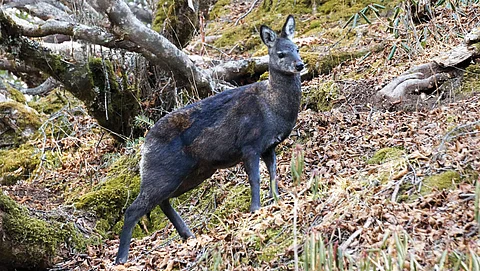

A Central Zoo Authority report reveals a mix-up in identifying the Alpine musk deer for conservation breeding, mistakenly initiating programs for the Himalayan musk deer instead.
This misidentification highlights the challenges in animal conservation efforts in India, with no clarity on the Alpine musk deer's population, which is critically endangered according to the IUCN's 2014 assessment.
There has been a confusion in correctly distinguishing this species [the Alpine musk deer (Moschus chrysogaster)] from the Himalayan Musk Deer (Moschus leucogaster), which is distributed from the western to eastern Himalayas. Due to their sympatric distribution, it is possible that zoos have misidentified these species,” states a Central Zoo Authority (CZA) report released in December 2024.
The startling admission in CZA’s “Planned Breeding Programs in Indian Zoos: Assessment and Strategic Actions (2024)” refers to the misidentification of the Alpine musk deer—an endangered species found in the central to eastern Himalayas—for its conservation breeding programme being run at two locations, Uttarakhand and West Bengal. Instead of the Alpine musk deer, the zoos seemingly initiated a conservation breeding programme of the Himalayan musk deer. “The historic population at the Musk Deer Breeding Centre near Chopta, Uttarakhand, and individuals housed at Padmaja Naidu Himalayan Zoological Park, Darjeeling, were probably M. chrysogaster. Currently, no recognized zoo reports holding captive stock of this species, suggesting that a breeding program was never initiated,” the report says.
Consequently, there is no clarity on the number of Alpine musk deer numbers. The website of Beauty Without Cruelty–India, an international educational charitable trust based in Pune, says that there were about 1,000 species in the wild in the 1980s. “There are no recent estimates available for the current population of Alpine musk deer... in its natural habitat. According to the IUCN’s [the International Union for Conservation of Nature’s] 2014 assessment, the species’ population is declining and is categorized as ‘Critically Endangered’,” says the CZA report.
“There is no hesitation in saying that breeding programmes for the Himalayan musk deer in India have completely failed. The case of wrong identification is symptomatic of the confusion that pervades animal conservation efforts in the country,” says B C Choudhury, retired professor and senior wildlife biologist at Wildlife Institute of India, Dehradun. “We do not even have a founder stock for musk deer breeding. So how can we think about the science that follows?” he adds.
Captive-breeding programmes in the country are decided by CZA. Constituted in 1992 under the Wild Life (Protection) Act, 1972, CZA is a statutory body under the Union Ministry of Environment, Forest and Climate Change. The Act mandates CZA to “identify endangered species of wild animals for purposes of captive breeding” and “assigning responsibility in this regard to a zoo”. In 2022, the government amended the Act to expand the definition of zoo, which now means “an establishment, whether stationary or mobile, where captive animals are kept for exhibiting to the public or ex-situ conservation and includes a circus and off-exhibit facilities such as rescue centres and conservation breeding centres, but does not include an establishment of a licensed dealer in captive animals”, says the report. The amendment, which includes conservation breeding centres under the definition of zoos, “reflects the growing recognition of their role in ex-situ conservation efforts. By including these centers within the definition of a zoo, the Act brings them under its regulatory framework,” the report adds.
To assess how much money CZA has spent on the Alpine musk deer programme in zoos so far, Down To Earth (DTE) filed an application with the Union Ministry of Environment, Forest and Climate Change on July 25, 2022 under the Right to Information (RTI) Act, 2005, asking “details of the amount spent on musk deer conservation”. On August 16, 2022, the ministry responded that it did not have the data. “Information sought is not available with this CPIO [Central Public Information Officer]. The management of Protected Areas is primarily the responsibility of concerned State/UT Government. However, Ministry provides financial assistance to States/UTs under the Centrally Sponsored Schemes of Development of Wildlife Habitats for management of wildlife and its habitats in the country [sic],” states the RTI response.
The CZA report, however, does give an estimate on the total money allocated to zoos on all the breeding programmes in India. “Between 2006 and 2011, approximately Rs 10.81 crores (R108.1 million) was allocated to zoos for establishing these programs,” it states, and later mentions another allocation of “Rs 18.13 crores (Rs 181.1 million) to zoos engaged in planned breeding programs between 2011 and 2021”. This brings the total money allocated to breeding programmes between 2006 and 2021 to Rs 28.94 crore.
India has undertaken conservation breeding programmes since the 1960s, but none were focused attempts at conservation, says Choudhury. However, after the constitution of CZA in 1992, the apex zoo authority identified 35 species of mammals, birds and reptiles for this purpose. By 2011, a total of 74 species across 43 zoos were identified to pilot this initiative. “Over time, 26 species (of the 74 identified) were prioritized… to receive financial assistance for establishing dedicated facilities for conservation breeding & cover operational expenses. The conservation breeding programs envisioned the creation of a population of 250 pedigreed individuals per targeted species, with at least 100 individuals housed within Indian zoos as part of a globally managed population,” says the report.
The report stresses that now no new species should be added to planned breeding programmes. It also says that the IUCN Red List of Threatened Species is outdated and reflects global conditions rather than country-specific scenarios, which means India needs to develop its own comprehensive list.
This article was originally published in the August 1-15, 2025 print edition of Down To Earth